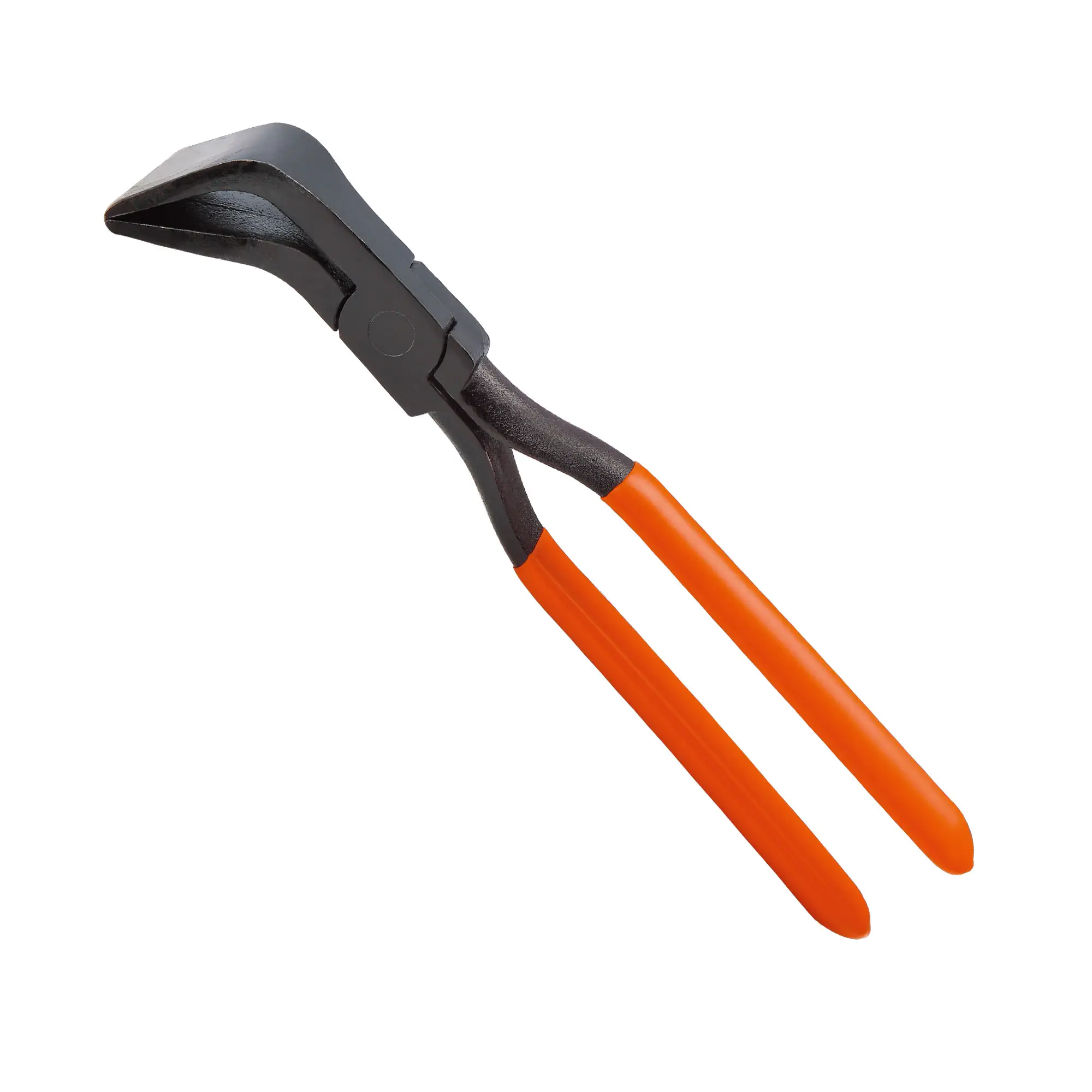Understanding Your Project Requirements
Assessing Material Types (Metal vs. Other Materials)
When picking out bending pliers, start by looking at what kind of materials are going into the job. Metals such as steel and aluminum call for heavy duty pliers that can take a beating while still holding onto whatever needs bending. Take steel for example it really puts tools through their paces because of how hard and thick it tends to be. The right pliers here need good torque capacity and solid construction to get the job done right. Plastic parts or thin wires tell a different story though. These generally work fine with standard pliers most of the time. Knowing whether something bends easily or resists deformation makes all the difference when choosing equipment. Material specs matter a lot in workshop settings where getting the wrong tool means wasted time and frustration. A craftsman who understands these differences stands a much better chance of selecting pliers that actually match what the project demands instead of just hoping they'll work.
Identifying Common Bending Tasks
Knowing what kind of bending work needs doing makes all the difference when picking out bending pliers. Some jobs involve shaping wire for jewelry pieces, others need loops formed in metal sheets, and there's also the matter of tweaking electronic parts. The level of detail required varies quite a bit between these tasks, so different pliers come with their own special features. Take jewelry making for instance it demands really fine control since those tiny bends have to look just right. On the flip side, working on electronics usually calls for pliers that can hold things securely without slipping during those small adjustments. Getting a handle on how complicated the bends actually are tells us whether we need something specifically made for detailed work or if regular pliers would get the job done for straightforward projects. Matching tools to the job at hand means less frustration down the line and better results overall because the right pliers make such a big difference in practice.
Essential Types of Bending Pliers
Flat Nose Bending Pliers for Precision Work
Flat nose pliers come in handy when someone needs to make those sharp bends and angles that regular pliers just can't handle. Jewelers and folks working on small electronic components rely heavily on these tools because they have those wide flat jaws that really bite into material without letting it slip around. The design gives users much better control over what they're doing, especially when shaping thin wires or delicate metals. Most workshops will find these pliers sitting right next to their other essentials since they work so well across different projects where getting things just right matters most. From bending jump rings to forming intricate shapes in sheet metal, these pliers deliver consistent results time after time.
Round Nose Bending Pliers for Loops and Curves
Round nose pliers have become essential for anyone wanting to shape loops and curves in wire and metal work. The design features rounded, tapered jaws that make those smooth bends possible, which is why so many jewelers rely on them for that polished look their customers expect. Working with these tools requires paying attention to wire thickness though too thin and the metal might snap, too thick and the pliers won't grip properly. From simple earrings to elaborate pendants and even detailed wire sculptures, experienced crafters know these pliers can transform raw materials into beautiful creations when used correctly. Many hobbyists find themselves reaching for round nose pliers again and again because they just seem to get the job done right most of the time.
Specialized Bending Pliers for Specific Needs
Chain Nose and Long Nose Bending Pliers
When dealing with tight spots, chain nose and long nose pliers become absolute must-haves for anyone working on small projects. Chain nose pliers really shine at grabbing hold and twisting things around in those awkward corners, almost like they extend the fingertips themselves. Jewelers and folks working on electronic components appreciate this kind of control since tiny details matter so much in their craft. Long nose pliers serve a different purpose altogether though. They let hands reach deep into narrow gaps while still maintaining that same level of accuracy needed for complicated builds. Getting familiar with which tool works best for what situation makes all the difference in producing high quality results. Most experienced hobbyists know instinctively when to switch between these two essential tools based on what needs doing at any given moment.
Combination Bending Pliers for Versatility
Combination pliers pack a punch when it comes to versatility since they do both gripping and cutting jobs right out of the box, which saves space in any toolbox. Most handymen love these because they can bend wires without fuss or cut through different materials pretty quickly. Electricians find them indispensable during installations while plumbers reach for them all the time too. The real advantage shows up when someone needs to switch between精细 work like trimming small components and tougher stuff like snipping thick cables mid-job. Getting a good pair means fewer trips back to grab another tool, and honestly, who doesn't want that extra efficiency when working on tight deadlines?
Evaluating Material and Construction Quality
Choosing Durable Metals for Longevity
The kind of metal in bending pliers makes all the difference when it comes to how long they last. High carbon steel or tool steel stand out as top picks since they really boost the lifespan and toughness of these tools. What sets these materials apart is their strength and capacity to handle stress, which explains why they work so well during regular use. Stainless steel pliers tell a different story though. They resist corrosion much better than other options. For anyone dealing with damp conditions regularly, this matters a lot since it stops rust formation and keeps the tool looking good over time. Looking into established manufacturers who prioritize quality materials helps guarantee that the bending pliers will perform reliably for years to come, giving users a solid investment that stands up against wear and tear.
Ergonomic Handles for Comfort and Control
When professionals pick out pliers, they're not really thinking about comfort first. What matters most is getting things done efficiently and staying safe on the job site. The right ergonomic handle design actually cuts down on hand fatigue after hours of continuous tool use something every tradesperson knows all too well. Soft rubber grips or those with special textures offer much better hold than standard plastic ones, cutting down on slips that could lead to serious injuries. Better grip means tighter control over what we're working on, which makes all the difference when dealing with delicate components or tight spaces. And let's face it folks, good ergonomics isn't just nice to have it becomes essential when tackling complex repairs where even minor mistakes cost time and money. Smart shops invest in quality ergonomic pliers because these tools literally change how work gets done across the board.

Matching Bending Pliers to Your Tasks
Selecting Tools for Detailed Craftsmanship
For anyone tackling detailed craftsmanship projects, picking out good bending pliers makes all the difference when it comes to getting things just right. The actual shape and tip of these tools need to match what kind of bends and curves we want to make in our materials. Fine tipped pliers really shine during those intricate bits of work where bigger tools just don't cut it. Think about stuff like how thick the wire is and how complicated the overall design looks before settling on a pair. Someone trying to bend delicate silver wire versus heavy duty copper will definitely need different equipment. Getting this right not only saves time but also means fewer mistakes and better looking finished pieces overall.
Heavy-Duty Bending Pliers for Metal Projects
When working on serious metal fabrication jobs, heavy duty bending pliers become absolutely essential for getting the job done right. What sets these apart from regular pliers? Look at those reinforced joints and thickened handles that tell anyone looking at them they're built for tough work. Most pros keep a pair of these bad boys in their toolbox because they just don't break down when pressure is applied. Metalworkers know that investing in quality heavy duty pliers pays off in the long run. They not only make the work go smoother but also prevent accidents caused by tools failing mid-project. Anyone who regularly deals with metalwork will quickly realize why these specialized tools belong in every well-equipped workshop.
Safety Tips and Maintenance Practices
Proper Handling Techniques to Prevent Injury
When working with bending pliers, knowing how to handle them right really makes a difference in staying safe from injuries. Most folks find that holding the pliers with both hands gives better control and keeps things steady when pressure needs to be applied. Slipping happens less often this way. Before getting started on any job, take a quick look at those pliers. If there's anything wrong with them like cracks or worn handles, they might break mid-job and cause some serious problems. Safety glasses should definitely be part of the gear too, along with thick work gloves. These protect fingers from flying bits of metal and keep hands from getting cut if something goes wrong. Following these basic steps cuts down accident chances quite a bit and makes almost every project safer overall.
Routine Care to Extend Tool Lifespan
Keeping bending pliers well maintained will help them last much longer than neglecting them. Start by giving them a good clean after handling anything corrosive, this keeps the metal from breaking down over time. Lubricating those moving parts makes everything work smoother and stops rust from forming, which definitely improves how they perform day to day. A dry storage spot away from moisture goes a long way too, cutting down on wear and tear while keeping the tools ready when needed. Following these basic steps means better tool condition overall and peace of mind knowing they'll handle whatever bending job comes along without failing at critical moments.
FAQ
What types of materials require high-strength bending pliers?
Materials like steel and aluminum, which are dense and tough, require high-strength bending pliers to handle the rigorous force needed without losing grip or precision.
How can I choose the right pliers for intricate tasks?
For intricate tasks, select pliers with fine tips to achieve the precision needed for complex bends and shapes, particularly in jewelry making and detailed craftsmanship.
What are combination bending pliers used for?
Combination bending pliers are versatile tools used for both gripping and cutting, catering to a wide range of tasks from detail-oriented to heavy-duty projects.
Why is the durability of bending pliers important?
Durability ensures that the pliers can withstand stress and regular use, particularly when made from high-carbon steel or stainless steel that resists corrosion and wear.
What are the benefits of ergonomic handles on bending pliers?
Ergonomic handles help reduce fatigue, provide a superior grip, and enhance control, making them crucial for safety and accuracy during prolonged use.


